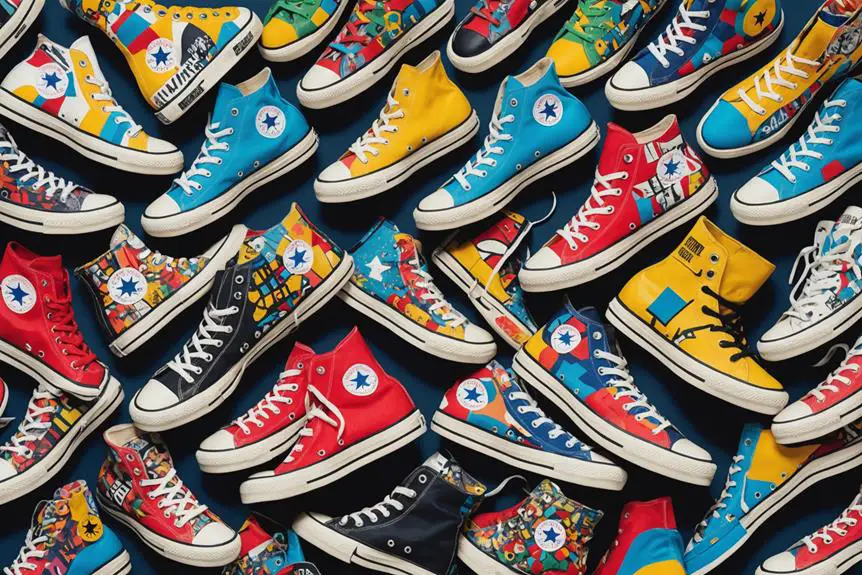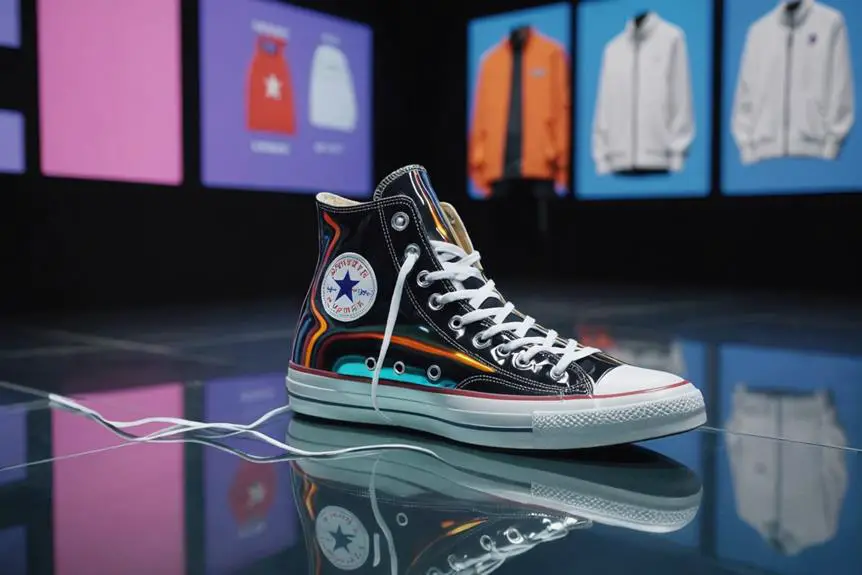When you think of Converse, you're stepping into a rich history that began in 1908 with the creation of durable footwear. The introduction of the Chuck Taylor All Star in 1917 revolutionized athletic shoes, making a significant impact both on the court and in street fashion. Its cultural significance soared, particularly during the punk and skate movements of the 70s and 80s, where it became a symbol of rebellion and self-expression. After encountering challenges in the early 2000s, Converse experienced a resurgence under Nike's ownership, broadening its collaborations and diversifying its product lines. Today, the brand artfully blends its storied heritage with contemporary innovation, solidifying its status in modern fashion culture. If you're interested in how this iconic brand continues to evolve, there's a wealth of information to explore.
Origins of Converse

In 1908, Converse was born in Malden, Massachusetts, thanks to Marquis Mills, who recognized the potential of rubber shoe construction. Initially focusing on durable rubber footwear, you can see how Converse laid the groundwork for a revolution in athletic footwear. By 1910, the company expanded its vision and began producing sneakers, quickly becoming a staple in American sports culture.
In 1917, the introduction of the Chuck Taylor All Star marked a pivotal moment in history, as it became North America's first mass-produced basketball shoe. This innovation wasn't just about style; it was about performance and accessibility for athletes. When Charles "Chuck" Taylor joined the company in 1921, his influence transformed the shoe into a cultural icon, ultimately leading to its renaming in 1932.
The Chuck Taylor All Star gained further prominence after being worn by the USA Olympic basketball team in 1936, cementing its legacy. During World War II, Converse shifted its focus to military footwear, showcasing its adaptability in an evolving market. This move not only contributed to its survival but also solidified its status in both athletic and casual footwear arenas.
The Chuck Taylor All Star
Converse's Chuck Taylor All Star isn't just a shoe; it's a cultural phenomenon that has shaped the landscape of sports and fashion since its debut in 1917. Originally introduced as the first mass-produced basketball shoe in North America, it featured a simple brown canvas design that soon evolved into a beloved icon. When Charles "Chuck" Taylor joined Converse in 1921, he transformed the shoe's destiny, leading to its renaming in 1932. His contributions in promotion and design helped secure its place in basketball history, achieving a staggering 90% market share by the 1960s.
The Chuck Taylor All Star transcended its athletic origins, morphing into a symbol of rebellion during the 1970s and 1980s, particularly within punk rock and skate cultures. As you slipped on these Converse shoes, you embraced a lifestyle that defied the norm. Even as the sneaker faced challenges in the late 1990s, it rebounded spectacularly post-Nike's acquisition in 2003, driving annual revenues over $2 billion by 2023. The Chuck Taylor All Star is not merely footwear; it's a reflection of enduring style and cultural significance in the world of sneaker brands.
Cultural Impact in Sports

The Chuck Taylor All Star's influence stretches far beyond its origins in basketball, impacting various dimensions of sports culture. Introduced in 1917 as the first mass-produced basketball shoe in North America, it quickly became a staple for athletes. By the 1960s, Converse held an impressive 90% market share in the basketball footwear industry, largely thanks to the All Star's widespread popularity among players. This shoe wasn't just footwear; it was a cultural icon, especially when it served as the official shoe for the USA Olympic basketball team from 1936 to 1968.
Chuck Taylor himself was inducted into the Basketball Hall of Fame in 1968, solidifying this connection. However, as the late 1980s brought a decline in professional basketball association, the All Star found new life. It was embraced by various subcultures, including punk and skateboarding, demonstrating its versatility beyond just athletic shoes. This transformation showcased how the Chuck Taylor transcended its initial purpose, becoming a symbol that resonates with diverse communities. In this way, the All Star not only shaped basketball but also left an indelible mark on the broader landscape of sports culture.
Evolution of Design
Since its debut in 1917, the Chuck Taylor All Star has undergone significant design changes while retaining its iconic silhouette. Originally crafted as the first mass-produced basketball shoe in North America, it featured a high-top design made from natural brown canvas. The 1930s saw the introduction of the iconic star logo, solidifying its identity within basketball culture.
As the years rolled on, Converse expanded the color palette, releasing classic black and white versions that became staples in serious basketball circles. This evolution didn't stop there; the materials shifted from traditional canvas to modern synthetic blends, enhancing durability and comfort without sacrificing the shoe's classic aesthetic.
Today, the Chuck Taylor All Stars aren't just basketball shoes; they've become a canvas for creativity. Collaborations with artists and designers have birthed limited edition variations that keep the design fresh and relevant in contemporary fashion. These adaptations highlight the shoe's ability to transcend its athletic roots, embracing a broader cultural identity. So, whether you're hitting the court or making a fashion statement, the Chuck Taylor remains a timeless choice that speaks to both tradition and innovation.
Market Challenges and Recovery

In the late 1990s and early 2000s, the once-thriving sneaker brand faced a perfect storm of market challenges, leading to its bankruptcy filing in 2001. Declining sales and fierce competition from giants like Nike and Adidas put Converse in a precarious position, threatening its iconic status. However, the tides turned in 2003 when Nike acquired Converse for approximately $309 million. This acquisition provided Converse with the resources it desperately needed to initiate a recovery.
Post-acquisition, Converse implemented innovative marketing strategies that highlighted its rich heritage and cultural relevance. This focus on storytelling resonated with consumers, especially around the beloved Chuck Taylor All Star, which became a symbol of youth culture. As a result, the brand experienced a resurgence in popularity, with revenue soaring over $1 billion by 2018. By 2023, Converse's revenue reached an impressive $2.4 billion, showcasing its successful adaptation into lifestyle products beyond just footwear.
The combination of Nike's backing and Converse's strategic pivot not only saved the brand from bankruptcy but also solidified its position as a staple in the sneaker market, demonstrating the power of resilience and innovation.
Innovations in Product Line
Innovations at Converse have redefined the brand's identity, showcasing its ability to blend tradition with contemporary design. The introduction of the Chuck Taylor II in 2015 marked a significant step, incorporating Nike's Lunarlon insole technology to enhance comfort. However, mixed reviews led to its discontinuation just a year later. In 2017, Converse re-emphasized its classic roots with the Chuck 70, a vintage-inspired update that maintained the iconic silhouette while integrating modern materials.
The brand's innovative spirit shone through collaborations, such as the 2016 Flame collection with Missoni, which featured unique zig-zag patterns, pushing the boundaries of footwear aesthetics. Additionally, the 2019 Goretex Pack showcased waterproof All Stars, a response to evolving consumer needs and environmental concerns without compromising style.
With the launch of the CONS line, Converse ventured into skateboarding, offering specialized designs that catered to a new demographic. This evolution highlights how Converse continuously adapts its product offerings, reinforcing its legacy while appealing to diverse lifestyles. Through these innovations, Converse not only honors its past but also embraces the future, ensuring its relevance in an ever-changing market.
Collaborations and Partnerships

Through a dynamic interplay of creativity and culture, Converse has forged powerful collaborations that not only elevate its brand but also resonate deeply with diverse audiences. By partnering with renowned artists and designers, Converse blends fashion with cultural movements, showcasing the versatility of the iconic Chuck Taylor.
| Collaboration | Impact |
|---|---|
| Missoni (2016) | Introduced vibrant zig-zag patterns, merging high fashion with streetwear. |
| Off-White (Virgil Abloh) | Solidified Converse's status in high-fashion circles, bringing a fresh aesthetic. |
| Vince Staples (2018) | Connected music culture with footwear, exemplifying Converse's cultural relevance. |
| 1Hund (RED) (2023) | Featured 100 global artists, supporting HIV/AIDS initiatives, highlighting social responsibility. |
These collaborations not only serve to enhance the aesthetic appeal of Converse products but also allow the brand to play a pivotal role in social causes and cultural movements. By intertwining their legacy with the creative visions of influential figures, Converse continues to inspire you to express yourself through both fashion and meaningful contributions to society.
Modern Brand Identity
At the heart of Converse's modern brand identity lies a powerful connection to street culture and youth movements, blending functionality with style for urban life. This synergy of heritage and innovation has transformed Converse into a global fashion staple. Since its acquisition by Nike in 2003, the brand has leveraged advanced technology and resources, enhancing product offerings while staying true to its roots.
Your experience with Converse goes beyond just wearing sneakers; it's about participating in a cultural narrative. The brand's innovative collaborations with artists and designers have solidified its relevance in contemporary fashion, weaving the fabric of street culture into every pair of shoes. These partnerships reflect a broader trend, showcasing how brands can engage with diverse demographics and foster creativity.
In 2023, Converse's revenue soared to approximately $2.4 billion, illustrating its successful navigation through the competitive fashion landscape. The brand continues to honor its legacy by supporting essential cultural movements, such as the 1Hund (RED) collection, which contributes to HIV/AIDS prevention efforts. This commitment not only enhances brand identity but also cements Converse's role in shaping and supporting the creative dynamics of modern society.
Future Directions

As Converse looks to the future, it's clear that sustainability and innovation will guide its path forward. The brand is committed to integrating eco-friendly materials into its product lines, guaranteeing that each limited edition release prioritizes environmental impact. This shift not only appeals to environmentally conscious consumers but also aligns with broader market trends favoring sustainable practices.
You'll notice that Converse has expanded beyond footwear into lifestyle products, including apparel, which reflects changing consumer preferences. By doing so, Converse effectively captures a wider audience while keeping the iconic Chuck Taylor relevant across diverse demographics. This classic design remains a staple in both athletic and streetwear culture, resonating with various age groups.
Moreover, Converse actively engages with modern consumers through social media marketing, collaborating with artists and influencers to maintain its relevance in today's fashion landscape. Future product innovations promise to blend advanced technologies with the beloved classic design that has defined Converse for over a century. This interdisciplinary approach guarantees that the brand not only keeps pace with contemporary trends but also shapes them, solidifying its position as a leader in sustainable fashion.
Frequently Asked Questions
What Were Converse Originally Made For?
Converse shoes were originally made for functionality and durability, designed to withstand wear and tear. You'd appreciate their robust nature, as they aimed to provide reliable support for various activities, especially outdoor and athletic pursuits.
How Did Converse Become so Popular?
You see, Converse became popular by blending sport and culture, appealing to diverse audiences. Its timeless design, embraced by rebels and artists alike, created a unique identity that resonates with people across generations and lifestyles.
What Does "Converse" Stand For?
"Converse" stands for the Converse Rubber Shoe Company, emphasizing its roots in rubber footwear. You'll find that this name reflects a legacy of innovation and cultural significance, shaping perceptions in both sports and fashion.
Why Did Marquis Mills Converse Create Converse?
Marquis Mills Converse created Converse to fulfill a growing demand for high-quality footwear. He envisioned a brand that combined practicality and style, which ultimately evolved into iconic athletic shoes, capturing both sport and fashion enthusiasts.





Your point of view caught my eye and was very interesting. Thanks. I have a question for you.
Nassau Airport to Atlantis transportation offers a seamless travel experience with comfortable, reliable shuttle and limo services. Whether you’re arriving or departing, enjoy luxury rides, punctual service, and professional chauffeurs ensuring stress-free transfers from Nassau Airport to Atlantis Resort Paradise Island.